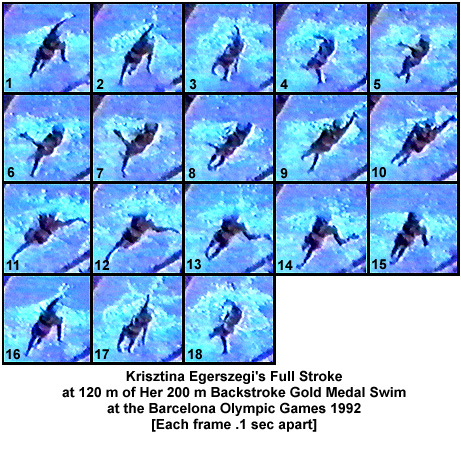Which arm motion works best is a big argument among elite swimmers and their coaches but a university research study has picked a winner - which will be no comfort at at all to actual athletes and their coaches.
In the 1960s, the sculling stroke gained popularity thanks to the late James "Doc" Counsilman, then the head men's swimming coach at Indiana University. Counsilman, highly regarded for his science-based approach to swimming stroke mechanics, also was head coach of the U.S. men's swim team that won a combined 21 gold medals in the 1964 and 1976 Olympic Games. Counsilman encouraged his swimmers to use the propeller-like sculling stroke, in which the elbow is raised to a higher position and the arm moves inward and outward in an S-shaped, propeller-like pattern during the propulsion phase of the stroke, when the swimmer's hand is pushing on the water.
The academic contend that the deep catch stroke, resembling a paddle, has the edge over sculling, the bent-arm, propeller-inspired motion. To make the determination, Rajat Mittal, a mechanical engineering professor at Johns Hopkins University, and his team started with high-precision laser scans and underwater videos of elite swimmers. The researchers then used animation software to bend and otherwise change the shape of the static arm in such a way as to match the video sequence. This software allowed the researcher to insert a "joint" into the arm so that the limb could be moved in a realistic manner. The team then ran computer simulations to study the flow of fluid around the arm and the forces that acted upon the limb.
Each simulation involved about 4 million degrees of freedom and thousands of hours of computer processing time.

Cappaert, J. M.,&Rushall, B. S. (1994). Biomechanical analyses of champion swimmers. Spring Valley, CA: Sports Science Associates. Photo: Brent S. Rushall, Ph.D., R.Psy
Mittal is a recreational swimmer and his research into motion through water began almost a decade ago when he was awarded a U.S. Navy grant to figure out how fish use their fins to swim so well. To tackle this task, Mittal's team developed software and computer models to study the movement of marine animals. Mittal later contacted USA Swimming to see if he might use these high-tech tools to crack the secrets of elite swimmers. Russell Mark, the biomechanics coordinator of USA Swimming, provided Mittal's team with underwater videos of top swimmers and startup funding. With this support, they collaborated on studies of the "dolphin kick" used in butterfly events and, increasingly, during starts and turns in freestyle and backstroke races.
After completing that study for USA Swimming, they turned their attention to the debate among top coaches about the merits of deep catch and sculling strokes. They first considered Counsilman's reasoning. "A propeller, when it rotates, is producing a lift force, and it is that lift force that pushes a boat forward," Mittal said. "Counsilman believed that to travel efficiently in a fluid, a swimmer should be using lift forces."
This contradicted the advice given by many swimming instructors. "In the past, the analogy for a swimming stroke was that it was like a paddle in a boat: put the paddle in the water, push it back as hard as possible. This is called drag-based propulsion. You're actually dragging the water back, and the water drags you forward," said Mittal.
Counsilman insisted that the lift force, generated by that propeller-like movement, was a more effective way of producing thrust than drag force. But Loebbecke's research suggests that the fluid dynamics of this stroke are more complicated than the renowned coach had imagined.
"Sculling, in my view, is a swimming stroke that is based on an incomplete understanding of fluid mechanics," Mittal said. "We found that Doc Counsilman was not correct overall about the sculling, but in some ways he was more correct than he would have ever thought. We did find that lift is indeed a major component in thrust production for both strokes, and that certainly indicates that the arm does not behave simply like a paddle. However, the simulations also indicate that exaggerated sculling motions, which are designed to enhance and exploit lift, actually reduce both the lift and drag contributions to thrust. So, lift is in fact important, but not in the way envisioned by these early coaches who were trying to bring fluid mechanics into swimming."
Many top swimmers use variations of the classic deep catch and sculling strokes and, outside of competitive swimming, the findings could be useful in designing exoskeleton suits that the U.S. Navy is seeking to help elite military forces swim more quickly and efficiently. The research could also have more down-to-earth applications by steering recreational swimmers toward the most effective strokes.
"People sometimes stop swimming because they feel they are not doing it well enough," he said. "If this research can help recreational swimmers swim more effectively and feel better about their swimming at an early stage, I think that could have an impact on health and fitness."
The findings concerning the deep catch and sculling strokes were featured in the doctoral thesis of Alfred von Loebbecke, who studied under Mittal, and in a report by Loebbecke and Mittal that has been accepted for publication in the Journal of Biomechanical Engineering.





Comments